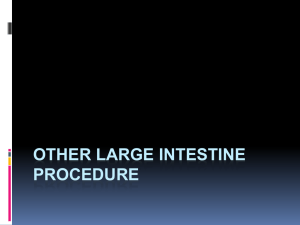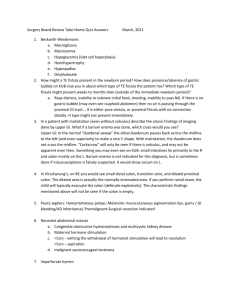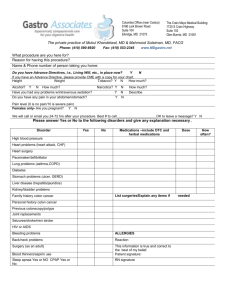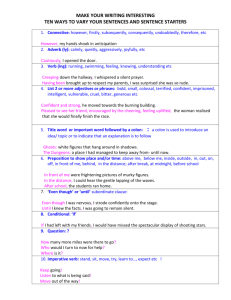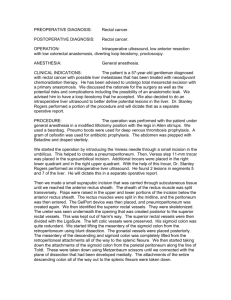Don't Be Obstructed By Colon Surgery Objectives
advertisement
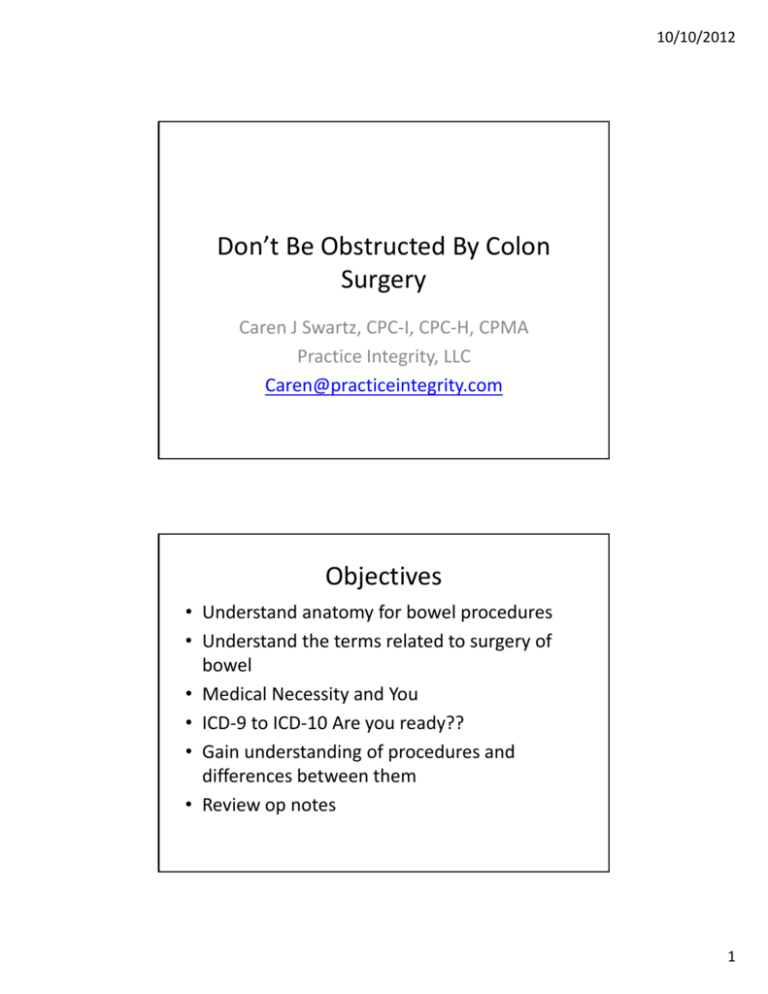
10/10/2012 Don’t Be Obstructed By Colon Surgery Caren J Swartz, CPC‐I, CPC‐H, CPMA Practice Integrity, LLC Caren@practiceintegrity.com Objectives • Understand anatomy for bowel procedures Understand the terms related to surgery of • Understand the terms related to surgery of bowel • Medical Necessity and You • ICD‐9 to ICD‐10 Are you ready?? • Gain understanding of procedures and g p differences between them • Review op notes 1 10/10/2012 Anatomy Anatomy 2 10/10/2012 Anatomy Right side – ileocecal valve, ascending colon p curve of large bowel on the g To hepatic flexure – right side of the body, ascending to transverse. To the Transverse Colon – moving horizontally across the abdomen To the splenic flexure – curve of the left side attaching transverse and descending colon Left side – descending colon to sigmoid to rectum and finally anus Anatomy 3‐D lets review and answer questions 3 10/10/2012 What is mesentery?? Mesentery – Supporting membrane: a membrane that supports an organ or body part, especially the double‐layered membrane of the peritoneum attached to the back wall of the abdominal cavity that supports the small and large intestine y pp g Medical Necessity Medicare defines "medical necessity" as services or items reasonable and necessary for the diagnosis or treatment of illness or injury or to improve the functioning of a malformed body member 4 10/10/2012 Medical Necessity Consider that CMS (formerly HCFA) has the power under the Social Security Act to power under the Social Security Act to determine if the method of treating a patient in the particular case is reasonable and necessary on a case‐by‐case basis. Even if a service is reasonable and necessary, coverage may be limited if the service is provided more frequently limited if the service is provided more frequently than allowed under a national coverage policy, a local medical policy or a clinically accepted standard of practice. Medical Necessity Consider any NCD or LCD for medical necessity. LCD will change with regions/MAC’s 5 10/10/2012 Medical Necessity “ Medicare carrier and fiscal intermediary Local Coverage Determinations (LCD) and National Coverage Determinations (NCD) succinctly define medical necessity requirements. C Covered diagnoses, documentation requirements, and d di d i i d limitations of coverage for specific services are also included in the many promulgated LCDs and NCDs that serve as a roadmap for a provider’s establishment of medical necessity. Despite these guidelines, challenges continue to surface regarding how to establish medical necessity. Ultimately, a physician’s clinical judgment is the guiding principle behind the appropriateness of medical necessity when it comes to the appropriateness of medical necessity when it comes to inpatient versus outpatient observation designation. “ Glenn Krauss/HCPro ICD‐9 to 10 • • • • • • Neoplasm Obstruction Intussception Stricture Perforation Complications from some other source 6 10/10/2012 Compare, You Ready?? ICD‐9 • Neoplasm – p 153 – 154 – stated or presumed primary – Neuroendocrine tumor – 209 – Code First any multiple endocrine neoplasia syndrome (258.01 ‐.03) – Use Additional code for assoc endocrine syndrome y i.e.(259.2) – Metastatic to Nodes – 196 – secondary by location ICD‐10 • Neoplasm ‐C18, C19, C20, p C21 – Neuroendocrine tumor – C7a.xxx – Code First any multiple endocrine neoplasia syndrome (E31.2x) – Use Additional code for assoc Use Additional code for assoc endocrine syndrome i.e.(E34.0) – Nodes – metastatic – C77.x ICD‐10 • Additional coding – Crohns Disease category has been expanded, includes the complication, i.e. obstruction, bleeding K50.xxx – Asking for you to code manifestation, if known – Same expansion for Ulcerative Colitis – K51.xxx – Other disease and disorder – K55, K56, K57, K58, K59 7 10/10/2012 Clear documentation is the key to this transition Modifiers • ‐22 • ‐59 59 • ‐76 ‐ ‐77 • ‐78 ‐ ‐79 • ‐80 ‐ ‐AS How do we apply these? How do we apply these? What documentation should be there for support? 8 10/10/2012 ‐22 • CPT states the “documentation must support additional work(increased intensity, time, dditi l k(i d i t it ti technical difficulty of procedure, severity of condition and physical/mental effort required” What will this look like in a note? What will this look like in a note? Are you savvy enough to guide your physician in documentation of this? Examples of ‐22 • “Adhesiolysis was performed for 2 hours due to the patients prior abdominal surgery The to the patients prior abdominal surgery. The abdomen was like concrete and required tedious lysis so as to be careful not to injure the bowel.” • “An extended right colectomy was done, this required going beyond the hepatic flexure and required going beyond the hepatic flexure and into the transverse colon to get a good margin.” 9 10/10/2012 ‐22 ‐59 • Know your CCI edits – Do you understand how to use this? – Column’s 1 and 2 • Don’t be afraid to use it! • www.cms.gov/medicare/nationalcorrectcoding 10 10/10/2012 CCI The National Correct Coding Initiative (NCCI) Th N ti lC t C di I iti ti (NCCI) (also known as CCI) was implemented to promote national correct coding methodologies and to control improper coding leading to inappropriate payment. NCCI code pair edits are automated prepayment edits that prevent automated prepayment edits that prevent improper payment when certain codes are submitted together for Part B‐covered services. How to use CCI If a provider submits the two codes of an edit If a provider submits the two codes of an edit pair, the Column 1 code is eligible for payment and the Column 2 code is denied. However, if both codes are clinically appropriate and an appropriate NCCI‐associated modifier is used the codes in both columns are is used, the codes in both columns are eligible for payment. Supporting documentation must be in the beneficiary’s medical record. 11 10/10/2012 Modifier Indicator • MODIFIER INDICATOR/DEFINITION • 0 ‐ 0 (Not Allowed) (Not Allowed) There are no modifiers There are no modifiers associated with NCCI that are allowed to be used with this code pair; there are no circumstances in which both procedures of the code pair should be paid for the same beneficiary on the same day by the same provider. • 1 ‐ (Allowed) ‐ The modifiers associated with NCCI are allowed with this code pair when appropriate. ll d h h d h • 9 ‐ (Not Applicable) ‐ This indicator means that an NCCI edit does not apply to this code pair. The edit for this code pair was deleted retroactively. Modifier ‐59 • Modifier ‐59 is an important NCCI‐associated modifier that is often used incorrectly. For the NCCI its primary purpose is to indicate that two or more procedures are performed at different anatomic sites or different patient encounters. It should only be used if no other modifier more appropriately describes the relationships of the two or more procedure codes. 12 10/10/2012 ‐59 and Diagnosis Use of modifier ‐59 to indicate different procedures/surgeries does not require a d / i d t i different diagnosis for each HCPCS/CPT coded procedure/surgery. Additionally, different diagnoses are not adequate criteria for use of modifier ‐59. The HCPCS/CPT codes remain bundled unless the procedures/surgeries are performed at different anatomic sites or separate patient encounters. Terms ‐ostomy – a new permanent opening ‐ectomy – t surgical removal (excision) i l l( i i ) ‐itis ‐ inflammation Anastomosis – suture tubular structures together y destruction/freeing/breakdown / g/ • Lysis – • Proximal – closest to point of origin • Distal – farthest from • • • • 13 10/10/2012 Approach • • • • Open Laparoscopic Davinci Percutaneous – What about “hand assisted?” – thoughts?? The Procedures 14 10/10/2012 Colectomy Codes 44140 – Open ‐ resection of a segment of colon with an anastomosis between the proximal and distal ends 44204 Laparoscopic approach – 44204 – Laparoscopic approach same same procedure Colectomy 44141 – Area of Colon is selected and divided both Area of Colon is selected and divided both proximally and distally with diseased segment removed. The proximal end is brought out through the abdomen for a colostomy or an anastomosis done and a loop colostomy performed proximal to the anastomosis. f d i l h i 15 10/10/2012 Partial Colectomy 44143 – (Hartman Procedure) Resection of colon, brings the proximal end of the colon out through the abdominal wall onto the skin as a colostomy. The distal end is closed with staples or sutures and left in the abdomen. Hartman Pouch 16 10/10/2012 Partial Colectomy 44144 – mucous fistula – not done much anymore, since the creation of the Hartman i th ti f th H t procedure (44143) was done for the same reason (diverticulitis) in this procedure the diseased colon is resected and BOTH ends proximal and distal, are brought out through the abdominal wall onto the skin as a “double barrel” colostomy. Mucous fistula/Double barrel Colostomy 17 10/10/2012 Partial Colectomy 44145 – coloproctostomy – low pelvic anastomosis – t i resection of distal colon or ti f di t l l rectum, then creates an anastomosis of the proximal colon and the remaining rectum low in the pelvis, with staples or sutures. Partial Colectomy 44146 ‐ coloproctostomy – low pelvic anastomosis – t i resection of distal colon and/or ti f di t l l d/ rectum, then creates an anastomosis of the proximal colon and the remaining rectum low in the pelvis, with staples or sutures. Finally, an area proximal to the anastomosis is chosen for Loop colostomy, usually temporary while the anastomosis heals. 18 10/10/2012 Partial Colectomy 44147 Combined abdominal and transanal approach, surgeon begins with abdomen, mobilizes the distal colon and rectum. Continues the dissection from below, transanal. The diseased p portion removed and an anastomosis between the two ends is performed. Add on Code + 44139 – Mobilization (take‐down) of splenic fl flexure with partial colectomy ith ti l l t (use in conjunction with 44140‐44147) Attachments are dissected free and “taken down” to freely move the colon. This adds in a later “tension later, tension free free” anastomosis. anastomosis 19 10/10/2012 Partial Colectomy 44160 – removal of a segment of the colon ( i ht id (right side or ascending) and the terminal ileum di ) d th t i l il and performs an anastomosis between the remaining ileum and colon. Thus a right colectomy. Total Colectomy 44150 / 44151 – removal of entire colon, without rectum…. ith t t 44150 – then creates an ileostomy (Brooke), OR a ileoproctostomy (anastomosis between small bowel and rectum) 44151 – with continent ileostomy (Kock) 44151 with continent ileostomy (Kock) 20 10/10/2012 Total Colectomy 44155/44156/44157/44158 – 44155 ‐ Abdominal excision/removal of the entire colon and rectum(proctectomy)…the distal rectum is removed through a perineal approach. The terminal ileum is brought out through abdomen for ileostomy. g y 44156 – forms a pouch with a valve with ileum (Kock) Total Colectomy 44157 – Excision of the entire colon as well as rectum and strips the mucosa (membrane that lines the GI tract) from the distal rectum. Anastomosis is then made from ileum, below the sphincter, to the anus. This procedure may also have a loop of ileum proximal to the anastomosis brought of ileum, proximal to the anastomosis, brought out to the abdomen as a loop ileostomy. 21 10/10/2012 Why mucosectomy?? Allows the physician to remove all of the colon, while preserving the sphincter on a patient that is at risk for cancer in the colon mucosa Total Colectomy 44158 – Again, all colon and rectum are removed, mucosectomy may be performed. In this procedure the ileum is folded onto itself forming a pouch. That pouch then pulled down through the sphincter and approximated (sutured) to the the sphincter and approximated (sutured) to the anus. As with 44157 a loop ileostomy may be done also. 22 10/10/2012 Knowledge Shot! A word about continent ileostomy(no appliance/bag) Dr Kock described this appliance/bag)..Dr. Kock described this procedure in 1969. 50% failed this treatment. This ostomy leaked and caused issues for the patient. Modifications were made and another doctor (Barnett) went on to improve this procedure, but still there are issues and procedure, but still there are issues and therefore not widely done anymore. (Won’t your Dr’s be SO impressed when you can discuss this??) Kock Pouch Formation 23 10/10/2012 Colostomy or Skin Level Cecostomy 44320 – Colostomy or skin level cecostomy Abdominal incision is made, peritoneum is entered, the distal end of the bowel is brought out through the abdomen, and matured as a colostomy Loop Colostomy 24 10/10/2012 Revisions 44340/44345 – The stoma is dissected free of any scar tissue, stoma is reapproximated to the skin. May have additional colon pulled through with distal portion transected for revision. 44345 – is a revision with the site changed, 44345 is a revision with the site changed involving complete take‐down, with closure of initial site Revisions 44346 – Repair of paracolostomy hernia. Colostomy is taken down, via an abdominal incision. The hernia is repaired, and the end of the colon is, once again, brought out through a new site for a revised colostomy formation. i d l t f ti 25 10/10/2012 Paracolostomy/stomal hernia Meckel’s Definition ‐ A Meckel's diverticulum is a pouch on the wall of the lower part of the intestine th ll f th l t f th i t ti that is present at birth (congenital). The diverticulum may contain tissue that is identical to tissue of the stomach or pancreas. Approximately 2% of the population has a Meckel's diverticulum, but only a few people develop symptoms. 26 10/10/2012 Meckel’s Diverticulum Meckel’s diverticulum 44800 – Via an abdominal incision, the Meckel’s di ti l diverticulum is located in the terminal ileum. It i l t d i th t i l il It is then excised and the defect closed with suture or a stapling devise. May also be done by transecting and anastomosis. There can also be a communication (omphalomesenteric duct) between the umbilicus and the terminal ileum, which would be excised and repaired in the same fashion. 27 10/10/2012 Appendix 44950/44970 – appendix is mobilized, blood supply divided and appendix transected Laparoscopic is divided and appendix transected. Laparoscopic is stapled, open ‐ appendicele stump can be bovied/tied or tucked and sutured. +44955 – When done for indicted purpose at time of other major procedure (have path to support) 44960 ‐ Open unique to rupture – No Laparoscopic equivalent Incidental • What was the intent • Did we know there was disease • Is there pathology to support – These are all questions that should be asked when an incidental appendectomy is performed – If you can support it, then you can bill it! If you can support it then you can bill it! 28 10/10/2012 Acute Appendicitis Abdominoperineal Resection (APR) • Procedure for rectal or rectosigmoid junction cancer. • Involves removal of the rectum • With or Without colostomy 29 10/10/2012 APR Anatomy APR 45110 – y, p Abdominally, the proximal rectum is mobilized to the level of the anal sphincter muscles. The colon is divided above the pelvic brim. Attention is then turned to the perineum, where the anus and distal rectum are dissected free and removed. The proximal colon is then d d Th i l l i th brought out through the abdomen as a colostomy. 30 10/10/2012 Repairs • • • • • • Suture for injury or perforation – colorraphy Hernia Stricturoplasty Closure of ostomy sites Closure of ostomy sites Fistula repair prolapse Colorraphy 44604 – 44604 Suture repair of wound, perforation, ulcer, single or multiple without colostomy(no resection) 44605 – 44605 Same procedure, with colostomy formation 31 10/10/2012 Omentum +49905 – 0mental flap, intra‐abdominal (List separately in addition to code for primary procedure) An example might be using this in the repair of a colo vesical or colo vaginal fistula The omental colo‐vesical or colo‐vaginal fistula. The omental flap would act as a barrier, to prevent recurrence of fistula formation. Stricturoplasty 44615 – Surgeon locates area of stricture via an abdominal incision, area is incised in a longitudinal manner. Area may need dilitation. The area is then repaired transversely The area is then repaired transversely. *Crohn’s patients are classic for this procedure* 32 10/10/2012 Stricturoplasty Ostomy Closure 44620/44625/44626 – Ostomy closure is the take down of the ostomy, weather large or small bowel. The code will change if there is resection, other than, colorectal(44625) or with colorectal anastomosis(44626) closure of Hartman type ( ) yp procedure. 33 10/10/2012 Fistula Repair 44640/44650/44660 What is communicating? Skin and bowel, bowel to bowel, or bladder to bowel? In this procedure the surgeon will identify the area that is communicating the bowel resected area that is communicating, the bowel resected in the area of the fistula with anastomosis done and closure of both defects. Fistula 44660/44661 – For this procedure the bladder is involved. These codes change whether the intestine and/or bladder need to be resected to get proper repair. 34 10/10/2012 Proctopexy Done for prolapse, usually elderly Codes are both laparoscopic and open approach May be done with resection of sigmoid colon Proctopexy Open Approach 45540 – abdominal approach – rectum is pulled up and attached to sacrum Mesh may be used up and attached to sacrum. Mesh may be used. 45541 – perineal approach – same procedure, different approach through levator muscle, slack taken up, approximated to sacrum with or without mesh 45550 same as a 45540, with resection of 45550 – 45540 ith ti f sigmoid colon (laparoscopic 45400/45402) 35 10/10/2012 Hemorrhoid Surgery Anal Fistula 36 10/10/2012 Hemorrhoid Surgery Hemorrhoid surgery is basically varicose vein surgery in the rectum. There are 3 primary i th t Th 3 i columns that are affected with hemorrhoids. Left lateral, right anterior and right posterior. Hemorrhoids can be either internal, within the anal canal or external, at the anal opening. , p g External are painful and problematic. Internal are only problematic if the prolapse or bleed. Hemorrhoidectomy When coding for hemorrhoids, you need to consider method of treatment ( rubber band, id th d f t t t ( bb b d surgical excision or stapling device or ablation) Also are the hemorrhoids internal or external? How many columns are being treated? Was fissure or fistula addressed at the same Was fissure or fistula addressed at the same time as hemorrhoid surgery? 37 10/10/2012 Hemorrhoidectomy 46221 – internal, rubber band ligation(s) 46945/46946 – internal, ligation other than rubber band, 1 column or 2 or more columns 46320 – external, excision of thrombosed 46250 – external, hemorroidectomy, 2 or more columns (Note – if only one column is addressed CPT directs you to use the unlisted code 46999) Hemorrhoidectomy Combined Internal and External 46255 – single column/group 46260 – 2 or more columns 38 10/10/2012 Hemorrhoidectomy Combined Internal and External 46257 – single column/group with fissurectomy 46261 – 2 or more column/groups with fissurectomy Hemorrhoidectomy Combined Internal and External 46258 – single group/column with fistulectomy, including fissurectomy when performed 46262 – 2 or more columns with fistulectomy, including fissurectomy when performed 39 10/10/2012 Hemorrhoidopexy Since we learned that internal hemorrhoids are rarely known, unless they prolapse or bleed, l k l th l bl d there is now a way to take the prolapse and return it to it’s appropriate location. 46947 – hemorrhoidopexy, by stapling Hemorrhoidopexy PPH 40 10/10/2012 Colon Surgery Lets look at some notes and code! THANK YOU!!! Questions?? 41
